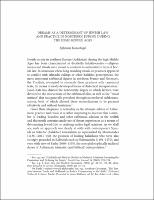Please use this identifier to cite or link to this item:
https://hdl.handle.net/20.500.12202/8516| Title: | Dreams as a determinant of Jewish law and practice in northern Europe during the high middle ages |
| Authors: | Kanarfogel, Ephraim Engel, David Schiffman, Lawrence Wolfson, Elliot 0000-0002-7539-7802 |
| Keywords: | rabbinic literature Medieval Jewish history halakhocentric—religious norms and rituals |
| Issue Date: | 2012 |
| Publisher: | Leiden: Brill |
| Citation: | Kanarfogel, E. (2012). Dreams as a determinant of Jewish law and practice in northern Europe during the high middle ages; In David Engel, Lawrence Schiffmann, Elliot Wolfson (eds.), "Studies in medieval Jewish intellectual and social history : festschrift in honor of Robert Chazan" (pp. 111-143). Leiden: Brill. |
| Abstract: | Jewish society in northern Europe (Ashkenaz) during the high Middle Ages has been characterized as decidedly halakhocentric—religious norms and rituals were meant to conform to authoritative texts of Jewish law. In situations where long-standing rituals or practices appeared to con!ict with talmudic rulings or other halakhic prescriptions, the most important rabbinical "gures in northern France and Germany, the Tosa"sts, attempted to reconcile these practices with canonized texts, by means of newly developed forms of dialectical interpretation.1 Jacob Katz has charted the noteworthy degree to which laymen were devoted to the instructions of the rabbinical elite, as well as the “ritual instinct” that was generally prevalent throughout medieval Ashkenazic society, both of which allowed these reconciliations to be pursued e#ectively and without hesitation.2 ¶ Given their allegiance to textuality as the ultimate arbiter of Ashkenazic practice and ritual, it is rather surprising to discover that a number of leading Tosa"sts and other rabbinical scholars in the twel$h and thirteenth centuries made use of dream experiences as a means of determining Jewish law or ratifying earlier legal opinions. As we shall see, such an approach was clearly at odds with contemporary Spanish or Sefardic (halakhic) rationalism as represented by Maimonides (1138–1204); with the position of leading halakhists who were also strongly grounded in Kabbalah such as Nahmanides (1194–1270); and even with view of Rashi (1040–1105), the non-philosophically inclined doyen of Ashkenazic talmudic (and biblical ) interpretation.3 |
| Description: | Scholarly book chapter |
| URI: | https://ebookcentral.proquest.com/lib/yeshiva-ebooks/reader.action?docID=848694&ppg=123 https://hdl.handle.net/20.500.12202/8516 |
| ISBN: | 9789004222366 |
| Appears in Collections: | Bernard Revel Graduate School of Jewish Studies (BRGS): Faculty Publications |
Files in This Item:
| File | Description | Size | Format | |
|---|---|---|---|---|
| Ephraim_Kanarfogel_Dreams_As_A_Determinant 111-143.pdf | 376.52 kB | Adobe PDF |  View/Open |
This item is licensed under a Creative Commons License

